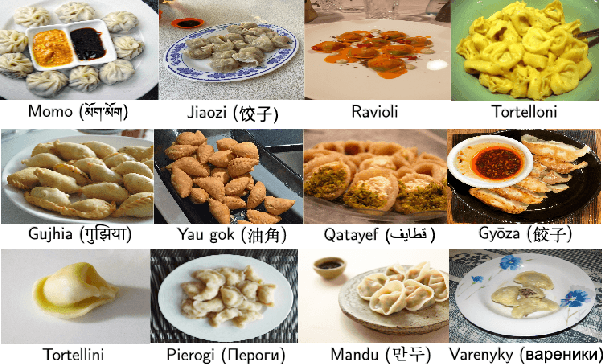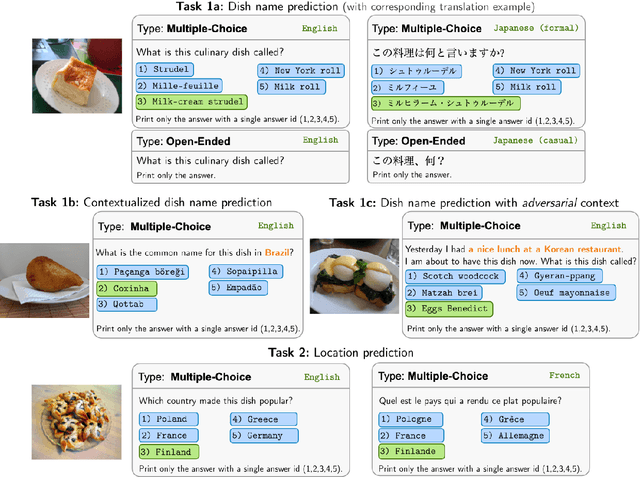Hanyang Zhao
R3: Robust Rubric-Agnostic Reward Models
May 19, 2025Abstract:Reward models are essential for aligning language model outputs with human preferences, yet existing approaches often lack both controllability and interpretability. These models are typically optimized for narrow objectives, limiting their generalizability to broader downstream tasks. Moreover, their scalar outputs are difficult to interpret without contextual reasoning. To address these limitations, we introduce R3, a novel reward modeling framework that is rubric-agnostic, generalizable across evaluation dimensions, and provides interpretable, reasoned score assignments. R3 enables more transparent and flexible evaluation of language models, supporting robust alignment with diverse human values and use cases. Our models, data, and code are available as open source at https://github.com/rubricreward/r3
Fine-Tuning Diffusion Generative Models via Rich Preference Optimization
Mar 13, 2025Abstract:We introduce Rich Preference Optimization (RPO), a novel pipeline that leverages rich feedback signals to improve the curation of preference pairs for fine-tuning text-to-image diffusion models. Traditional methods, like Diffusion-DPO, often rely solely on reward model labeling, which can be opaque, offer limited insights into the rationale behind preferences, and are prone to issues such as reward hacking or overfitting. In contrast, our approach begins with generating detailed critiques of synthesized images to extract reliable and actionable image editing instructions. By implementing these instructions, we create refined images, resulting in synthetic, informative preference pairs that serve as enhanced tuning datasets. We demonstrate the effectiveness of our pipeline and the resulting datasets in fine-tuning state-of-the-art diffusion models.
Score as Action: Fine-Tuning Diffusion Generative Models by Continuous-time Reinforcement Learning
Feb 03, 2025



Abstract:Reinforcement learning from human feedback (RLHF), which aligns a diffusion model with input prompt, has become a crucial step in building reliable generative AI models. Most works in this area use a discrete-time formulation, which is prone to induced errors, and often not applicable to models with higher-order/black-box solvers. The objective of this study is to develop a disciplined approach to fine-tune diffusion models using continuous-time RL, formulated as a stochastic control problem with a reward function that aligns the end result (terminal state) with input prompt. The key idea is to treat score matching as controls or actions, and thereby making connections to policy optimization and regularization in continuous-time RL. To carry out this idea, we lay out a new policy optimization framework for continuous-time RL, and illustrate its potential in enhancing the value networks design space via leveraging the structural property of diffusion models. We validate the advantages of our method by experiments in downstream tasks of fine-tuning large-scale Text2Image models of Stable Diffusion v1.5.
WorldCuisines: A Massive-Scale Benchmark for Multilingual and Multicultural Visual Question Answering on Global Cuisines
Oct 16, 2024



Abstract:Vision Language Models (VLMs) often struggle with culture-specific knowledge, particularly in languages other than English and in underrepresented cultural contexts. To evaluate their understanding of such knowledge, we introduce WorldCuisines, a massive-scale benchmark for multilingual and multicultural, visually grounded language understanding. This benchmark includes a visual question answering (VQA) dataset with text-image pairs across 30 languages and dialects, spanning 9 language families and featuring over 1 million data points, making it the largest multicultural VQA benchmark to date. It includes tasks for identifying dish names and their origins. We provide evaluation datasets in two sizes (12k and 60k instances) alongside a training dataset (1 million instances). Our findings show that while VLMs perform better with correct location context, they struggle with adversarial contexts and predicting specific regional cuisines and languages. To support future research, we release a knowledge base with annotated food entries and images along with the VQA data.
RainbowPO: A Unified Framework for Combining Improvements in Preference Optimization
Oct 05, 2024



Abstract:Recently, numerous preference optimization algorithms have been introduced as extensions to the Direct Preference Optimization (DPO) family. While these methods have successfully aligned models with human preferences, there is a lack of understanding regarding the contributions of their additional components. Moreover, fair and consistent comparisons are scarce, making it difficult to discern which components genuinely enhance downstream performance. In this work, we propose RainbowPO, a unified framework that demystifies the effectiveness of existing DPO methods by categorizing their key components into seven broad directions. We integrate these components into a single cohesive objective, enhancing the performance of each individual element. Through extensive experiments, we demonstrate that RainbowPO outperforms existing DPO variants. Additionally, we provide insights to guide researchers in developing new DPO methods and assist practitioners in their implementations.
Preference Tuning with Human Feedback on Language, Speech, and Vision Tasks: A Survey
Sep 17, 2024Abstract:Preference tuning is a crucial process for aligning deep generative models with human preferences. This survey offers a thorough overview of recent advancements in preference tuning and the integration of human feedback. The paper is organized into three main sections: 1) introduction and preliminaries: an introduction to reinforcement learning frameworks, preference tuning tasks, models, and datasets across various modalities: language, speech, and vision, as well as different policy approaches, 2) in-depth examination of each preference tuning approach: a detailed analysis of the methods used in preference tuning, and 3) applications, discussion, and future directions: an exploration of the applications of preference tuning in downstream tasks, including evaluation methods for different modalities, and an outlook on future research directions. Our objective is to present the latest methodologies in preference tuning and model alignment, enhancing the understanding of this field for researchers and practitioners. We hope to encourage further engagement and innovation in this area.
Scores as Actions: a framework of fine-tuning diffusion models by continuous-time reinforcement learning
Sep 12, 2024Abstract:Reinforcement Learning from human feedback (RLHF) has been shown a promising direction for aligning generative models with human intent and has also been explored in recent works for alignment of diffusion generative models. In this work, we provide a rigorous treatment by formulating the task of fine-tuning diffusion models, with reward functions learned from human feedback, as an exploratory continuous-time stochastic control problem. Our key idea lies in treating the score-matching functions as controls/actions, and upon this, we develop a unified framework from a continuous-time perspective, to employ reinforcement learning (RL) algorithms in terms of improving the generation quality of diffusion models. We also develop the corresponding continuous-time RL theory for policy optimization and regularization under assumptions of stochastic different equations driven environment. Experiments on the text-to-image (T2I) generation will be reported in the accompanied paper.
Mallows-DPO: Fine-Tune Your LLM with Preference Dispersions
May 23, 2024



Abstract:Direct Preference Optimization (DPO) has recently emerged as a popular approach to improve reinforcement learning with human feedback (RLHF), leading to better techniques to fine-tune large language models (LLM). A weakness of DPO, however, lies in its lack of capability to characterize the diversity of human preferences. Inspired by Mallows' theory of preference ranking, we develop in this paper a new approach, the Mallows-DPO. A distinct feature of this approach is a dispersion index, which reflects the dispersion of human preference to prompts. We show that existing DPO models can be reduced to special cases of this dispersion index, thus unified with Mallows-DPO. More importantly, we demonstrate (empirically) how to use this dispersion index to enhance the performance of DPO in a broad array of benchmark tasks, from synthetic bandit selection to controllable generations and dialogues, while maintaining great generalization capabilities.
Score-based Diffusion Models via Stochastic Differential Equations -- a Technical Tutorial
Feb 12, 2024Abstract:This is an expository article on the score-based diffusion models, with a particular focus on the formulation via stochastic differential equations (SDE). After a gentle introduction, we discuss the two pillars in the diffusion modeling -- sampling and score matching, which encompass the SDE/ODE sampling, score matching efficiency, the consistency model, and reinforcement learning. Short proofs are given to illustrate the main idea of the stated results. The article is primarily for introducing the beginners to the field, and practitioners may also find some analysis useful in designing new models or algorithms.
Contractive Diffusion Probabilistic Models
Jan 23, 2024



Abstract:Diffusion probabilistic models (DPMs) have emerged as a promising technology in generative modeling. The success of DPMs relies on two ingredients: time reversal of Markov diffusion processes and score matching. Most existing work implicitly assumes that score matching is close to perfect, while this assumption is questionable. In view of possibly unguaranteed score matching, we propose a new criterion -- the contraction of backward sampling in the design of DPMs. This leads to a novel class of contractive DPMs (CDPMs), including contractive Ornstein-Uhlenbeck (OU) processes and contractive sub-variance preserving (sub-VP) stochastic differential equations (SDEs). The key insight is that the contraction in the backward process narrows score matching errors, as well as discretization error. Thus, the proposed CDPMs are robust to both sources of error. Our proposal is supported by theoretical results, and is corroborated by experiments. Notably, contractive sub-VP shows the best performance among all known SDE-based DPMs on the CIFAR-10 dataset.
 Add to Chrome
Add to Chrome Add to Firefox
Add to Firefox Add to Edge
Add to Edge